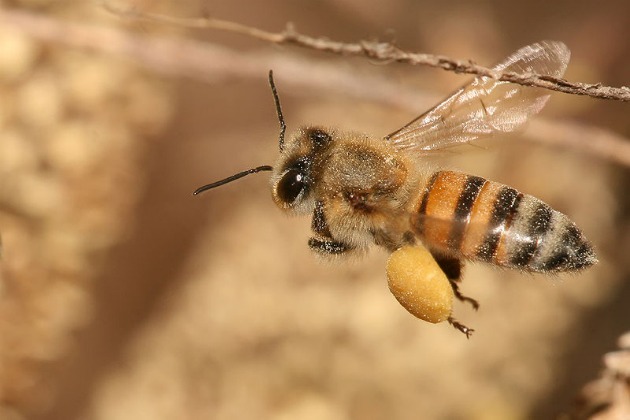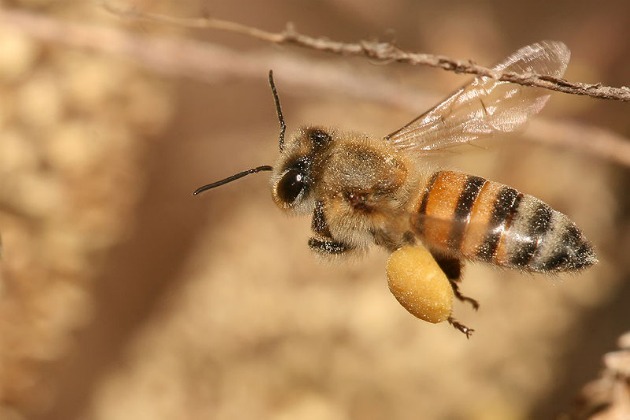 Buzz kill: honey bees face a variety of threats from industrial agriculture.Photo: Muhammad Mahdi KarimThere was a moment during a luncheon talk yesterday when Jeffrey Pettis, the United States Department of Agriculture’s lead bee researcher, almost defended Bayer, the agrichemical company whose pesticide he has tied to the global destruction of bee populations.
Buzz kill: honey bees face a variety of threats from industrial agriculture.Photo: Muhammad Mahdi KarimThere was a moment during a luncheon talk yesterday when Jeffrey Pettis, the United States Department of Agriculture’s lead bee researcher, almost defended Bayer, the agrichemical company whose pesticide he has tied to the global destruction of bee populations.
Pettis pointed out that the class of pesticides known as neonicotinoids were developed as a better alternative to pesticides like DDT. “They were replacing things we knew were really bad,” Pettis told the dozen or so naturalists, gardeners, and environmental advocates at the lunch at the Cosmos Club in D.C. Moreover, Bayer had offered products like pre-coated seeds for corn and cotton, which would limit the need to routinely spray whole fields with the treatment. “Even they thought they were targeting things a little better,” he said of the company.
But his tepid defense began and ended there. Most of the lunch, Pettis explained his research to the group, which was already familiar with the basics from reporting in the U.K. and in Grist. His research shows that neonicotinoids, from pre-coated seeds or treated crops, ooze out through the nectar, pollen, and water of plants like cotton and corn. Honeybees and other natural pollinators eat it, and even undetectable amounts most likely weaken their immune systems and make them susceptible to harmful pathogens they would be able to fight off when healthy.
Perhaps it’s unsurprising that a scientist would be reluctant to draw a straight causal line between the demonstrably harmful chemical to Colony Collapse Disorder, a now five- or six-years-long phenomenon in which chunks of the honeybee population in North America and Europe die off every winter. (In the first years, the die-offs jumped at alarming rates, but they have now stabilized. Scientists say we lose a third of our managed and wild bee populations every winter.) Pettis, fresh off a trip to London to brief Parliament on his research, repeated what he said there: The pesticides are, along with habitat destruction, monoculture, and other environmental problems, one of many contributing factors to the bee deaths.
Pettis also told the group that while lab results are clear, field results are not. Researchers have so far not been able to demonstrate that the pesticide harms bees in real-world conditions. Establishing clear evidence of harm is difficult, Pettis said, because honey-bee populations are big, incredibly mobile, and the natural world provides a lot of buffers — like a broad base of nutritional sources — that can mitigate the pesticide’s damage. He added that there are long-term studies in process examining the problem in field conditions.
Regardless, Germany, France, and Slovenia have banned use of the pesticide or limited it pending further study, and the U.K. is considering such a move. This key difference between U.S. policy and the policies of many other countries was a pressing issue for those at the lunch. Why isn’t the EPA, with which Pettis says he is in an ongoing dialogue, more cautious when it comes to using chemicals? Why isn’t it standard to wait until a chemical is proven to be safe to approve it, rather than wait until a chemical is proven to do harm to remove it? Harriet Crosby, a Friends of the Earth member who helped organize the talk, asked why the the European “precautionary principle” wasn’t in place here. Pettis sighed and shook his head. “There are higher demands for testing,” he said, with the muted conviction of a man who works for the slow-moving bureaucracy that is the federal government — which doesn’t mean he wasn’t sympathetic to their concerns. “I’m on the pollinators’ side” he said.
Scientists have noticed that, in some cases, honeybees will cap off nectar in a process called “entombment,” which will prevent other bees from eating it. The bees know something foreign is in the pollen, and that it’s hurting them. It’s a good predictor that the colony will die in two or three months. Pettis was asked by a beekeeper whether scientists can intervene after entombment to try to save the doomed bees. Pettis replied that researchers don’t know exactly what entombment means. The bees may be far too poisoned by that point to save, or they could be so nutritionally stressed that they need to eat the bad nectar anyway. But he walked through mitigation measures under way to keep bees from dying off in the winter: feeding them a high-fructose corn syrup mixture which itself may not be free of pesticides and feeding them a manmade protein supplement. None of these is as nutritionally rich as what the bees would ideally find in nature.
That’s the problem with American agricultural policy in general, of course. Neonicotinoids were a replacement for a chemical that decimated animal life until Rachel Carson wrote Silent Spring. Rather than rid ourselves of chemicals, we tried to find better ones. And when spraying whole fields proved dangerous, we decided that chemicals belonged in the plants themselves. Now these well-meaning solutions are killing off bees, which means that a key component of our food chain — insects that we may not even know about — are unable to do the pollinating work that keeps people fed. Rather than act quickly to take the chemical off the market, the most likely solution will be to try to put another bandaid on the problem — feed the bees alternatives, or find a new chemical, or find new pollinators. A bandaid won’t stitch together a gaping wound, and neither will it fix a problem that kills a third of the honeybee population once a year.




